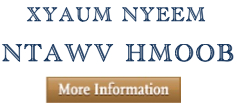History in China
IN THIS SECTION
The Thousand-Year Myth: Construction and Characterization of Hmong
by Mai Na M. Lee
Hmong Studies Journal v2n2 Spring 1998
Abstract
Coined only in the last twenty years, the phrase “Hmong means free” has been thoughtlessly promoted by both Hmong and non-Hmong alike. This phrase, however, simply manifests thousands of years of narrow, one-dimensional characterization of the Hmong. To historical oppressors of Hmong, “free” entails primitive savageness and inability to assimilate, or to enter the fold of what these outsiders defined as civilization. To outsiders, “free” also captures the essence of the warlike Hmong character, the Hmong’s inability to compromise on a peaceful, rational level. The author disputes this simple portrayal of Hmong and points to a historical diversity rivaling that of any human group. To various degrees, Hmong have assimilated culturally and politically in both the Chinese and French Indo-Chinese context. In addition, Hmong who have chosen to isolate themselves politically did so in response to unfair practices against them. Throughout, Hmong character and political history is complex. For this reason, the author urges Hmong to be cautious about embracing such a narrow, unfounded definition for the word “Hmong.”
Hmong
“Hmong,” the word which an obscure people use to identify themselves, was not known to the world until two decades ago. Politically marginalized, it took the mountains upon which the Hmong inhabited to echo their name across the hemispheres. This once unknown people has risen to the forefront of international debate as a result of their entanglement in the Vietnam Wars. Occupying a strategic geographical position, the Hmong served as a buffer against Communism in Laos playing an ambiguously controversial role. Hmong involvement in this painful conflict has made them the focus of much debate resulting in Hmong being perhaps one of the more well-known ethnic minority groups of Southeast Asia. Awareness of the Hmong as a people does not, however, mean that the Hmong have advanced significantly. In fact, the construction of the Hmong people is largely based upon speculative myths and traditional stereotypes of politically dominant groups. Consequently, analysis of Hmong history which stretches 4,500 years into the past, {2} goes little beyond regurgitated opinions. Today, the Hmong are as elusive and misrepresented as ever. The Hmong are not blameless in the processes which have contributed to the misunderstanding of themselves.
Let us begin with the name “Hmong” itself. Virtually all authors who have written about the Hmong since the 1970’s acknowledged the Hmong’s preference to be known as “Hmong.” In addition, almost everyone makes reference to the fact that the names “Miao” and “Meo,” used by outsiders to identify the Hmong people, have pejorative connotations. Yet most of these authors, even those of respectable scholarly background, have refused to establish the trend of labeling the Hmong by their preferred name, citing academic consistency and established tradition as excuses.{3} Today everyone and anyone who writes about Hmong is pulled into the debate of defining Hmong. Being here to discuss issues on Hmong I am also compelled to touch upon the name “Hmong.”
READ FULL ARTICLE FROM HMONG STUDIES JOURNAL
The Thousand-Year Myth (Construction and Characterization of Hmong) by Mai Na M. Lee







